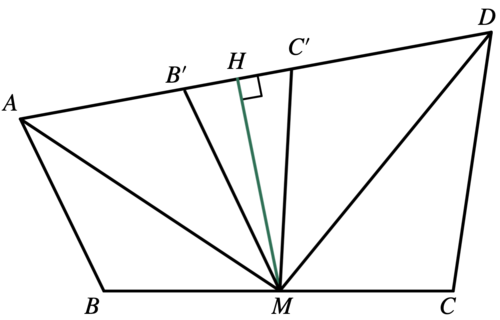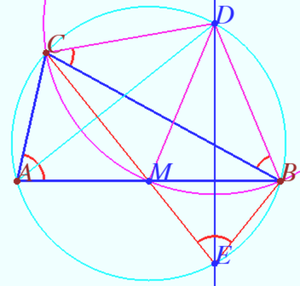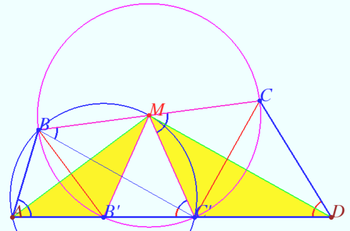Difference between revisions of "2022 AIME II Problems/Problem 11"
(→Solution 3 (Visual)) |
(→Solution 3 (Visual)) |
||
| Line 108: | Line 108: | ||
<b><i> Solution</b></i> | <b><i> Solution</b></i> | ||
| − | + | [[File:AIME 2022 11b.png|350px|right]] | |
Let <math>AB' = AB, DC' = DC, B'</math> and <math>C'</math> on <math>AD.</math> | Let <math>AB' = AB, DC' = DC, B'</math> and <math>C'</math> on <math>AD.</math> | ||
Then <math>AB' = 2, DC' = 3, B'C' = 2 = AB'.</math> | Then <math>AB' = 2, DC' = 3, B'C' = 2 = AB'.</math> | ||
Quadrilateral <math>ABMC'</math> is inscribed. | Quadrilateral <math>ABMC'</math> is inscribed. | ||
| + | Let <math>\angle A = 2\alpha.</math> Then <math>\angle MBC' = \angle MC'B = \alpha.</math> | ||
| + | |||
| + | Circle <math>BB'C'C</math> has center <math>M, BC</math> is its diameter, <math>\angle BC'C = 90^o.</math> | ||
| + | <math>\angle DMC' = \angle MC'B,</math> since they both complete <math>\angle MC'C</math> to <math>90^o.</math> | ||
| + | |||
| + | <math>\angle MB'A = \angle MC'D,</math> since they are the exterior angles of an isosceles <math>\triangle MB'C'.</math> | ||
| + | <math>\triangle AMB' \sim \triangle MDC'</math> by two angles. | ||
| + | <math>\frac {AB'}{MC'} = \frac {MB'}{DC'}, MC' =\sqrt{AB' \cdot C'D} = \sqrt{6}.</math> | ||
| + | |||
| + | The height dropped from <math>M</math> to <math>AD</math> is <math>\sqrt{MB'^2 - (\frac{B'C'}{2})^2} =\sqrt{6 - 1} = \sqrt{5}.</math> | ||
| + | |||
| + | The areas of triangles <math>\triangle AMB'</math> and <math>\triangle MC'B'</math> are equal to <math>\sqrt{5},</math> area of <math>\triangle MC'D</math> is <math>\frac{3}{2} \sqrt{5}.</math> | ||
| + | |||
| + | The areas of triangles <math>\triangle AMB'</math> and <math>\triangle AMB</math> as well as <math>\triangle MC'D</math> and <math>\triangle MCD</math> are equal. | ||
| + | |||
| + | The area of <math>ABCD</math> is <math>(1 + 2 + 3) \sqrt{5} = 6\sqrt{5},</math> its square is <math>\boxed{180}.</math> | ||
| + | |||
| + | ~vvsss, www.deoma-cmd.ru | ||
==See Also== | ==See Also== | ||
{{AIME box|year=2022|n=II|num-b=10|num-a=12}} | {{AIME box|year=2022|n=II|num-b=10|num-a=12}} | ||
{{MAA Notice}} | {{MAA Notice}} | ||
Revision as of 15:14, 1 June 2022
Problem
Let ![]() be a convex quadrilateral with
be a convex quadrilateral with ![]() ,
, ![]() , and
, and ![]() such that the bisectors of acute angles
such that the bisectors of acute angles ![]() and
and ![]() intersect at the midpoint of
intersect at the midpoint of ![]() . Find the square of the area of
. Find the square of the area of ![]() .
.
Solution 1
According to the problem, we have ![]() ,
, ![]() ,
, ![]() ,
, ![]() , and
, and ![]()
Because ![]() is the midpoint of
is the midpoint of ![]() , we have
, we have ![]() , so:
, so: ![]()
Then, we can see that ![]() is an isosceles triangle with
is an isosceles triangle with ![]()
Therefore, we could start our angle chasing: ![]() .
.
This is when we found that points ![]() ,
, ![]() ,
, ![]() , and
, and ![]() are on a circle. Thus,
are on a circle. Thus, ![]() . This is the time we found that
. This is the time we found that ![]() .
.
Thus, ![]()
Point ![]() is the midpoint of
is the midpoint of ![]() , and
, and ![]() .
. ![]() .
.
The area of this quadrilateral is the sum of areas of triangles: ![]()
![]()
![]()
![]()
Finally, the square of the area is ![]()
~DSAERF-CALMIT (https://binaryphi.site)
Solution 2
Denote by ![]() the midpoint of segment
the midpoint of segment ![]() .
Let points
.
Let points ![]() and
and ![]() be on segment
be on segment ![]() , such that
, such that ![]() and
and ![]() .
.
Denote ![]() ,
, ![]() ,
, ![]() ,
, ![]() .
.
Denote ![]() . Because
. Because ![]() is the midpoint of
is the midpoint of ![]() ,
, ![]() .
.
Because ![]() is the angle bisector of
is the angle bisector of ![]() and
and ![]() ,
, ![]() .
Hence,
.
Hence, ![]() and
and ![]() .
Hence,
.
Hence, ![]() .
.
Because ![]() is the angle bisector of
is the angle bisector of ![]() and
and ![]() ,
, ![]() .
Hence,
.
Hence, ![]() and
and ![]() .
Hence,
.
Hence, ![]() .
.
Because ![]() is the midpoint of segment
is the midpoint of segment ![]() ,
, ![]() .
Because
.
Because ![]() and
and ![]() ,
, ![]() .
.
Thus, ![]() .
.
Thus,
![]()
In ![]() ,
, ![]() .
In addition,
.
In addition, ![]() .
Thus,
.
Thus,
![]()
Taking ![]() , we get
, we get ![]() .
Taking
.
Taking ![]() , we get
, we get ![]() .
.
Therefore, ![]() .
.
Hence, ![]() and
and ![]() .
Thus,
.
Thus, ![]() and
and ![]() .
.
In ![]() , by applying the law of cosines,
, by applying the law of cosines, ![]() .
Hence,
.
Hence, ![]() .
Hence,
.
Hence, ![]() .
.
Therefore,

Therefore, the square of ![]() is
is ![]() .
.
~Steven Chen (www.professorchenedu.com)
Solution 3 (Visual)
Lemma
In the triangle ![]() is the midpoint of
is the midpoint of ![]() is the point of intersection of the circumscribed circle and the bisector of angle
is the point of intersection of the circumscribed circle and the bisector of angle ![]() Then
Then ![]()
Proof
Let ![]() Then
Then ![]()
Let ![]() be the intersection point of the perpendicular dropped from
be the intersection point of the perpendicular dropped from ![]() to
to ![]() with the circle.
with the circle.
Then the sum of arcs ![]()
![]()
Let ![]() be the point of intersection of the line
be the point of intersection of the line ![]() with the circle.
with the circle.
![]() is perpendicular to
is perpendicular to ![]() the sum of arcs
the sum of arcs ![]() hence
hence ![]() coincides with
coincides with ![]()
The inscribed angles ![]() is symmetric to
is symmetric to ![]() with respect to
with respect to ![]()
Solution
Let ![]() and
and ![]() on
on ![]() Then
Then ![]()
Quadrilateral ![]() is inscribed.
Let
is inscribed.
Let ![]() Then
Then ![]()
Circle ![]() has center
has center ![]() is its diameter,
is its diameter, ![]()
![]() since they both complete
since they both complete ![]() to
to ![]()
![]() since they are the exterior angles of an isosceles
since they are the exterior angles of an isosceles ![]()
![]() by two angles.
by two angles.
![]()
The height dropped from ![]() to
to ![]() is
is ![]()
The areas of triangles ![]() and
and ![]() are equal to
are equal to ![]() area of
area of ![]() is
is ![]()
The areas of triangles ![]() and
and ![]() as well as
as well as ![]() and
and ![]() are equal.
are equal.
The area of ![]() is
is ![]() its square is
its square is ![]()
~vvsss, www.deoma-cmd.ru
See Also
| 2022 AIME II (Problems • Answer Key • Resources) | ||
| Preceded by Problem 10 |
Followed by Problem 12 | |
| 1 • 2 • 3 • 4 • 5 • 6 • 7 • 8 • 9 • 10 • 11 • 12 • 13 • 14 • 15 | ||
| All AIME Problems and Solutions | ||
The problems on this page are copyrighted by the Mathematical Association of America's American Mathematics Competitions. ![]()












